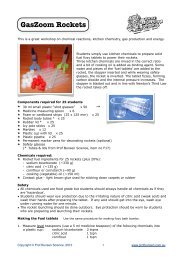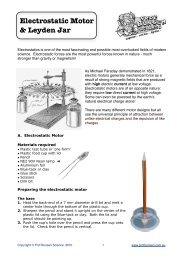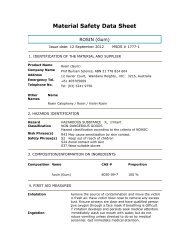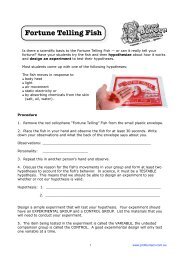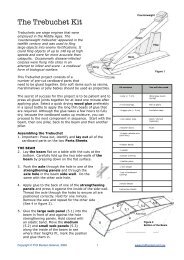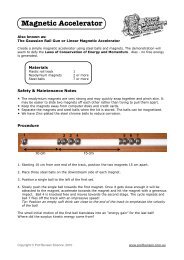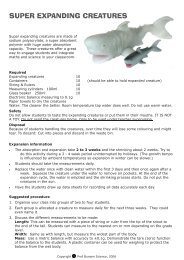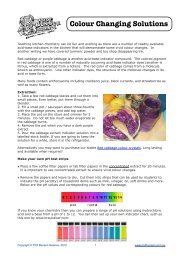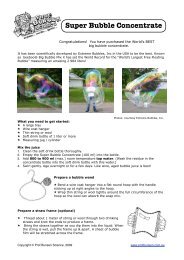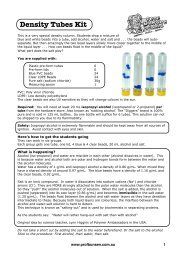Material Safety Data Sheet: CALCIUM CHLORIDE - Prof Bunsen
Material Safety Data Sheet: CALCIUM CHLORIDE - Prof Bunsen
Material Safety Data Sheet: CALCIUM CHLORIDE - Prof Bunsen
Create successful ePaper yourself
Turn your PDF publications into a flip-book with our unique Google optimized e-Paper software.
Respiratory Protection<br />
Eye Protection<br />
Hand Protection<br />
Body Protection<br />
against moisture as the presence of water will accelerate<br />
this deterioration.<br />
Where sufficient ventilation is not available, avoid<br />
breathing dust by wearing an AS 1716 approved particulate<br />
filter respirator.<br />
<strong>Safety</strong> glasses with side shields or goggles should be worn.<br />
The use of nitrile rubber gloves is recommended.<br />
Suitable workwear should be worn to protect clothing.<br />
PHYSICAL AND CHEMICAL PROPERTIES<br />
Appearance<br />
White, odourless fine crystals<br />
Melting Point 260°C<br />
Boiling Point 1600°C<br />
Solubility in Water Soluble<br />
pH Value<br />
approx. 5-8 (50 g/l H2O, 20°C)<br />
Flammability<br />
This product is non-combustible<br />
Molecular Weight 147.02<br />
STABILITY AND REACTIVITY<br />
Chemical Stability<br />
Incompatible <strong>Material</strong>s<br />
Hazardous Polymerization Will not occur.<br />
Other Information<br />
TOXICOLOGICAL INFORMATION<br />
Stable under ordinary conditions of use and storage. Substance<br />
will pick up moisture from the air and go into solution if exposed<br />
to air in open containers.<br />
Methyl vinyl ether, water, zinc, bromine trifluoride, mixtures of<br />
lime boric acid, barium chloride, and 2-furan percarboxylic acid.<br />
Metals will slowly corrode in aqueous calcium chloride solutions.<br />
Aluminum (and alloys) and yellow brass will be attacked.<br />
This product is strongly hygroscopic, therefore do not leave<br />
containers standing open.<br />
Toxicology Information<br />
Inhalation<br />
Ingestion<br />
Skin<br />
Eye<br />
Chronic Effects<br />
DISPOSAL<br />
Oral - LD50 (Rat) 1.4 g/kg<br />
Inhalation of dust may result in irritation of the mucous<br />
membrane and upper airways. Symptoms may include nausea,<br />
headaches, sneezing and possible breathing difficulties.<br />
Harmful if swallowed. May cause irritation to the mouth,<br />
esophagus and stomach if swallowed in large quantities.<br />
May cause mechanical irritation in contact with the skin, which<br />
may result in redness and itching.<br />
Will cause irritation in contact with the eyes, which can result in<br />
redness, stinging and lachrymation. Not anticipated to cause<br />
permanent eye injury.<br />
Prolonged or repeated contact with this material may result in<br />
irritation leading to possible contact dermatitis.<br />
Flush down sewer with large amounts of water.<br />
REGULATORY INFORMATION<br />
Poisons Schedule<br />
Hazard Category<br />
Not Scheduled<br />
Harmful, Irritant<br />
IMPORTANT ADVICE: This MSDS summarizes our best knowledge of the health and safety<br />
hazard information of the product and how to safely handle and use the product in the<br />
workplace / school laboratory. Each user should read this MSDS and consider the information<br />
in the context of how the product will be handled and used in the workplace including its use in<br />
conjunction with other products.<br />
2<br />
End of MSDS




